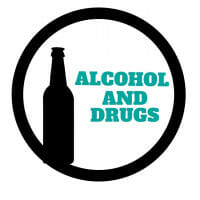
Know the Risks
If you choose to use alcohol, it’s important to be informed so that you can minimize your risk.
Following is some useful information to keep in mind when drinking:
BAC (Blood Alcohol Content)
Your blood-alcohol content is related to number of drinks you consume, the amount of time you drank them in, your weight and your gender. Download the R-U-Buzzed app in the Apple Store or Google Play Store to calculate your approximate BAC. The following list shows how your BAC correlates with how your body is likely to react.
| BAC | Likely Reaction |
| 0.02% | Relaxed (under 21, no driving) |
| 0.04% | Relaxation continues, buzz develops |
| 0.06% | Cognitive judgment is impaired |
| 0.08% | Nausea, motor coordination impaired (over 21, no driving) |
| 0.10% | Clear deterioration in cognitive judgment and motor coordination |
| 0.15%-0.25% | Blackout likely |
| 0.25%-0.35% | Passing out likely, loss of consciousness, risk of death |
| 0.40%-0.45% | Lethal dose |
Counting Drinks Accurately
BAC is calculated based on “standard drinks.” This is good to be aware of so you don’t drink more than you planned accidentally. One standard drink equals:
- 12 fluid ounces of beer (about 5 percent alcohol)
- 5 fluid ounces of wine (about 12 percent alcohol)
- 1.5 fluid ounces of hard alcohol like gin, whiskey, vodka, rum, tequila (about 40 percent alcohol, or 80 proof)
If you are drinking mixed drinks, make it yourself so that you always know exactly how much alcohol is in it.
Gender Differences
If a 150-pound man consumes four drinks in three hours, his BAC will be approximately 0.067 percent.
If a 150-pound female consumes four drinks in three hours, her BAC will be approximately 0.086 percent, which is higher than the legal limit to drive.
Here are some reasons why:
- Men have higher amounts enzymes that breaks alcohol down.
- Men tend to have more water in their body, which dilutes alcohol.
- For women who are on oral birth control, the pill may decrease the rate at which alcohol is eliminated from the body, which means that you may feel effects of alcohol longer.
- Menstruation can affect how fast the body absorbs alcohol.
Additional Tips
- Always have a designated driver.
- Alternate alcoholic and nonalcoholic drinks.
- Determine in advance a set number of standard drinks.
- Eat before and while drinking.
- Have a friend let you know when you’ve had enough.
- Pace your drinks over time.
- Avoid drinking games that require you to drink a lot quickly.
- Avoid shots.
- Drink for quality, not quantity.
- Don’t leave your drink unattended.
- Don’t accept a drink from someone else.
Marijuana
What is it?
Marijuana is the most commonly used illicit drug in the United States (SAMHSA, 2014). Marijuana is a plant mixture of dried and shredded leaves, stems, seeds and flowers of the hemp plant. This mixture can be green, brown or gray. Also, stronger forms of the drug include sinsemilla (sin-seh-me-yah), hashish (“hash” for short) and hash oil. The drug is used by smoking, eating and inhaling it.
There are more than 500 chemicals found in marijuana; delta-9-tetrahydrocannabinol, known as THC, is responsible for many of the drug’s psychotropic (mind-altering) effects. THC is the chemical that is responsible for changing how the brain works, and distorting how the mind perceives the world. It also moves quickly through the bloodstream to the brain and other organs throughout the body.
What Are the Risks?
The chemical THC acts on specific targets in the brain, called cannabinoid receptors. Ordinarily, these receptors are activated by brain chemicals similar to THC that are part of a neural communication system, and play an important role in brain development and function. Marijuana overactivates this system, causing impaired coordination, difficulty problem-solving and disrupted learning and memory.
Long-Term Effects
Marijuana has been known to cause impaired brain development in users. When users begin using as young adults, the drug may reduce thinking, memory and learning functions and affect how the brain builds connections between these areas necessary for function. Marijuana’s effects on these abilities may last a long time, or even be permanent.
Marijuana can be a highly addictive drug. It affects the brain’s reward system in the same way as all other drugs of addiction. In addition to the possible effects on your cognitive development, marijuana smoke is an irritant to the lungs, and frequent marijuana smokers can develop many of the same respiratory problems as tobacco smokers, such as:
- Daily cough and phlegm production
- More frequent acute chest illness
- Greater risk of chest infections
The Bottom Line
Marijuana has the potential to cause problems in your daily life, or make existing problems worse. It limits your brain’s effectiveness, slows down thinking and impairs coordination and judgment. And while you’re young and still maturing, marijuana could have a long-lasting, negative impact on your developing brain.
How Does Marijuana Affect the Brain?
Marijuana has both long-term and short-term effects on the brain. When a person smokes marijuana, THC quickly passes from the lungs into the bloodstream. The blood carries the chemical to the brain and other organs throughout the body. The body absorbs THC more slowly when the person eats it. In that case, the user generally feels the effects after 30 minutes to one hour.
Also, THC acts on specific brain cell receptors that ordinarily react to natural THC-like chemicals in the brain. These natural chemicals play a role in normal brain development and function.
Marijuana overactivates parts of the brain that contain the highest number of these receptors. This causes the “high” that users feel. Other common effects from marijuana use include:
- Altered senses (for example seeing brighter colors)
- Altered sense of time
- Mood changes
- Impaired body movements
- Difficulty concentrating and problem-solving
- Impaired memory function
Mental Effects of Marijuana Use
Long-term marijuana use has been linked to mental illnesses such as:
- Depression
- Anxiety
- Suicidal thoughts
Physical Effects of Marijuana Use
Physical effects of marijuana use include:
- Breathing problems
- Increased heart rate
- Problems with child development during and after pregnancy
What Is Medical Marijuana?
The marijuana plant has been found to contain chemicals that may be useful for treating a range of illnesses or symptoms. A growing number of states have legalized the plant’s use for certain medical conditions.
Legal Issues of Marijuana
Across the United States, marijuana state laws for adult use are changing. Many states have passed laws that allow for the use of marijuana as a treatment for certain medical conditions. Due to the serious concerns over the harm to the developing teen brain and the risk of driving under the influence, marijuana use by people under age 21 is prohibited in all U.S. states.
State Laws Related to Marijuana
The Office of National Drug Control Policy states that in 1996, 23 states and Washington, DC have passed laws allowing for smoked marijuana to be used for a variety of medical reasons.
However, it is important to note that these state marijuana laws do not change the fact that using marijuana continues to be an offense under Federal law. Nor do the state laws change the criteria or process for FDA approval of safe and effective medications (Office of National Drug Control Policy).
The state laws vary in areas such as their criteria, and process, and many states are experiencing internal debates about the safety, efficacy, and legality of their marijuana laws. Many local governments are even creating zoning and enforcement ordinances that prevent marijuana dispensaries from operating in their communities. Regulation of marijuana for medical use may also exist at the county and city level, in addition to state laws.
Moreover, it is important to understand that Congress has determined that marijuana is a dangerous drug and that the illegal distribution and sale of marijuana is a serious crime (Office of National Drug Control Policy).
Merrimack’s Drug Policy
Merrimack College has long recognized the dangers of illicit drug use as well as the misuse of prescription drugs, and is intent on enforcing federal, state and local regulations regarding such. In addition, Merrimack College has established its own specific regulations regarding such drug use. These regulations include but are not limited to:
- Possession, use, manufacture, sale or distribution of federally defined illegal drugs and controlled substances, including but not limited to, marijuana, narcotics, barbiturates, hallucinogens or amphetamines is prohibited by college students, whether on or off campus.
- Medicinal marijuana is not permitted in housing provided by the college.
- Impairment due to illicit drug use is not permitted anywhere on campus. A person is considered impaired due to drug use if that use substantially interferes with judgment and decision-making, results in destructive or disruptive behavior, and/or requires the intervention of college personnel.
- Behavioral symptoms that will be considered in determining impairment include, but are not limited to, impaired motor skill/coordination, difficulty communicating, vomiting, glazed/red eyes, and verbal and/or physical aggressiveness.
- Misuse, abuse, possession, sale or distribution of prescription medications is prohibited. The possession of a medication prescribed for someone else is also prohibited.
For further reading please view the Merrimack College Student Handbook
What Should I Do If Someone I Know Needs Help?
If you have a concern of a medical, mental health or safety issue that cannot or should not wait, please call campus police at 978-837-5911, dial 911 or go directly to the nearest emergency room.
Students can make appointments with Hamel Health counseling services for Monday through Friday, 9 a.m. to 4:30 p.m. by calling 978-837-5441. You may also walk in with an emergency anytime.
Please refer to the Hamel Health website for additional questions.

